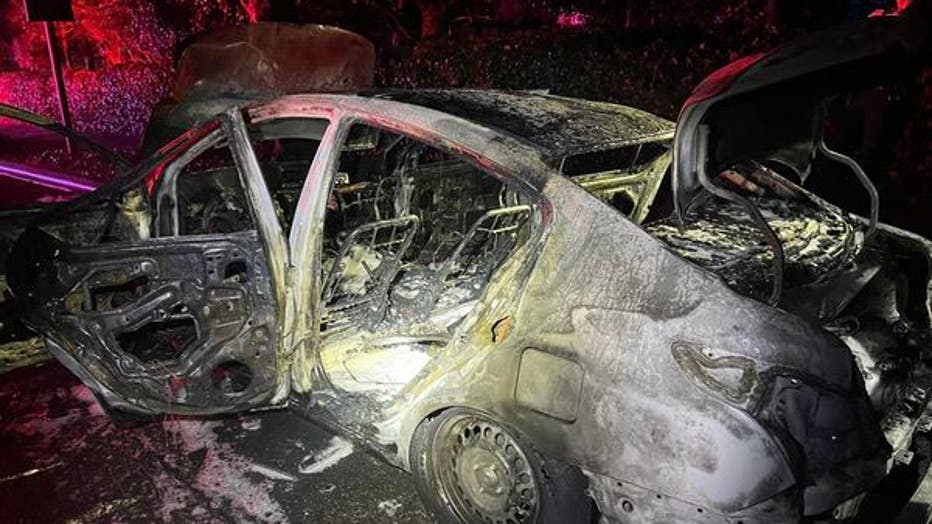Crime drops in California despite narrative that it's not

Crime drops in California despite narrative that it's not
Statistics show crime was down in the state, and some say false narratives led to unwarranted anti-crime legislation.
OAKLAND, Calif. - The latest statistics from California show that crime in nearly every major crime category was down last year, despite narratives last year that made many in the public fear that crime rates were at an all-time high.
Crime down in California
Data released Tuesday by the California Department of Justice shows that in 2024, violent crime, property crime, homicides, aggravated assaults, motor vehicle theft, burglary, and robbery all dropped. At the end of last year, San Francisco touted the lowest homicide rate in 60 years. Overall, Oakland also had a 34% reduction in homicides and shootings in 2024 compared to the year before.
Statewide, the homicide rate was the second-lowest since 1966.
One crime category persisted, however. Shoplifting was up statewide in 2024 by 14%.
These numbers fly in the face of the storylines many moderate and conservative voices pushed last year. Some of those narratives resulted in the historic recalls of Oakland Mayor Sheng Thao and Alameda County Public Defender Pamela Price and motivated Gov. Gavin Newsom to bring in the California Highway Patrol, which he touted made 7,300 arrests, recovered more than 5,000 stolen vehicles and confiscated 350 guns across Bakersfield, San Bernardino and Oakland.

Bay Area Council pushes for CHP deployment to reduce BART crimes
After recent attacks on or near BART trains, there are calls to get crimes under control with a renewed effort to deploy highway patrol officers, even though BART leaders say they have a handle on it.
Politics of crime
"Well, there's crime, and there's the politics of crime," said Santa Clara University law professor W. David Ball, who noted that crime in the United States has decreased steadily since the 1970s, despite Americans feeling otherwise.
He said it might have made political sense to oust Sheng and Price, but "that doesn't really have to do with the underlying dynamics of what is going on, right?"
Pro-public safety
Pro-public safety supporters, like the governor and police chiefs, point to their methods and investments in the crime drop.
Newsom chose to use the DOJ numbers to tout how California "made the choice to invest — not abandon — our communities."
California, Newsom stressed, has invested $1.6 billion since 2019 to fight crime, including the largest investment to combat organized retail crime in state history.
Newsom also highlighted that he signed the most "significant bipartisan legislation to crack down on property crime in modern California history."
And last year, voters passed Proposition 36, a new law that allows prosecutors to charge people convicted of a third-time drug offense with treatment-mandated felony in lieu of jail or prison.
Then-San Francisco Police Chief Bill Scott credited the police department's "data-driven strategies" and detectives solving crimes as the reasons why homicide rates were so low.
And Oakland Police Sgt. Huy Nguyen, who is president of the police union, said that the "most important thing to recognize is the hard work of the men and women putting on the uniforms, the CHP coming to our city, our officers out there answering calls and doing what they can within the constraints and lack of staffing that we have."
Magnus Lofstrom, policy director and senior fellow at the Public Policy Institute of California, gave some credence to these policing strategies, saying that some of these methods were behind many of the crime categories declining to below where they were in 2019, right before the COVID pandemic.
He noted some outliers, too, such as shoplifting being up 14% despite crime-fighting efforts and property crime going down to the lowest levels in the last 40 or 50 years.
"If you take a slightly longer perspective, and you compare crime rates in Oakland in 2024 to what they were before the pandemic, they're higher," Lofstrom said. "The data is definitely pointing towards decreases in crime in Oakland in 2024, but even with those decreases, they are still higher than they were before the pandemic."
Lofstrom said he believed these numbers are "very encouraging."

A car in Piedmont was set on fire in an arson case, police said. May 17, 2024. Photo: Piedmont police
Crime crackdowns unwarranted
Those on the left used the numbers to show that crime crackdowns were unwarranted and wrong.
Advocates with Californians for Safety and Justice issued a news release showing that the push for Prop. 36 was "sold by proponents" and has been "rendered provably false."
"Proposition 36 was a solution in search of a problem, and these numbers offer incontrovertible evidence of that," said Tinisch Hollins, executive director of Californians for Safety and Justice. "A temporary spike in property crime during the pandemic was weaponized to push a carceral agenda. They ran a fear-based campaign rooted in misinformation. They created a panic about property crime at the very moment property crime rates hit an all-time low."
Crime debate complicated
Several criminologists say that these numbers are not surprising – and neither is the rhetoric on either side of the crime debate.
Reygan Cunningham, co-director of the California Partnership for Safe Communities, who has helped both Oakland and San Francisco reduce crime levels with data-driving policing techniques along with providing social service help, said it's simply too early to tell the reasons for any nationwide reductions.
And Ball added that despite what any one person says or does regarding the myriad of reasons people commit crimes, there is never one reason that people kill, shoplift or break into houses.
"Politicians take the credit and they also take the blame," Ball said. "And I don't know that in either instance it's really that warranted. The answer is, of course, it's complicated, which is what the law professor's answer to everything is."

